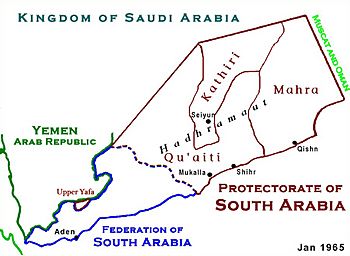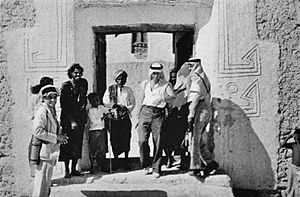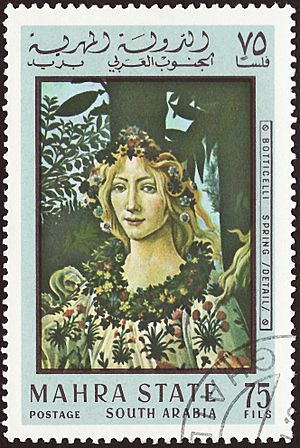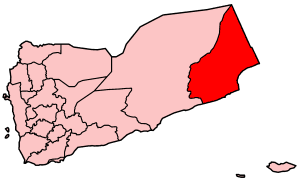Mahra Sultanate facts for kids
Quick facts for kids
Mahra State of Qishn and Socotra
|
|||||||||
|---|---|---|---|---|---|---|---|---|---|
| 1432–1967 | |||||||||
|
Flag
|
|||||||||

Location of Mahra within the Protectorate of South Arabia
|
|||||||||
| Capital | Shihr (until 1495) Qishn Tamrida/Hadibu |
||||||||
| Demonym(s) | Mahri | ||||||||
| Government | Monarchy | ||||||||
| History | |||||||||
|
• Established
|
1432 | ||||||||
|
• British protectorate
|
1886 | ||||||||
|
• Dissolved
|
30 November 1967 | ||||||||
|
|||||||||
| Today part of | Yemen | ||||||||
The Mahra Sultanate was a historical kingdom in what is now eastern Yemen. It was also known as the Mahra State of Qishn and Socotra. This sultanate included the region of Mahra on the mainland and the island of Socotra. The Banu Afrar family ruled this area for most of its history.
In 1886, the Mahra Sultanate became a British protectorate, meaning Britain helped protect it. Later, it joined the Aden Protectorate. The sultanate ended in 1967 when the People's Republic of South Yemen was formed. Today, the area is part of the Republic of Yemen.
The people who lived in the sultanate were called the Mahri. They spoke the Mehri language, which is an ancient language from South Arabia. The Mahri people have strong ties to their neighbors on Socotra island and in Dhofar, Oman. They share cultural traditions and a history of frankincense farming. The region has a special coastal climate, different from the surrounding desert, with a rainy season called the khareef or monsoon.
After the British left in 1967, the Mahra region was divided. The mainland became the Al Mahrah Governorate. Socotra island was managed by different areas until 2013. Then, it became its own separate governorate called Socotra Governorate.
Contents
Ancient Mahra: A Land of Frankincense
The story of the Mahra region goes back to ancient times. It began with the ʿĀd kingdom, an Arabian tribe that settled in South Arabia. The Mahri people are believed to be descendants of the ʿĀd Kingdom. They are also thought to be related to the Thamud people.
According to old Islamic family trees, the ancestor of the Mahri people was Ya'rub. He was the son of Qahtan and the grandson of the Prophet Hud. Ya'rub is sometimes even given credit for creating the Arabic language.
In ancient times, the ʿĀd Kingdom was a key stop on the Incense trade route. This route was used to trade frankincense, which was mostly sent to ancient Europe. Some people believe that the ʿĀd Kingdom, where Mahra is today, was the first place in the world where the camel was tamed and used by humans.
Mahra and the Rise of Islam
Becoming Muslim: A New Alliance
In the early 620s, a group of leaders from Mahra traveled to Medina. There, they met the Islamic prophet Muhammad. During this meeting, the entire Mahri tribe decided to become Muslims. Before this, they had worshiped many different gods.
After the meeting, Muhammad declared that the Mahri tribe were true Muslims. He said that no war should be fought against them. This decision helped the Mahri people. It gave them a strong political alliance and good relations with the new Muslim leaders in Medina. Before this, Al-Mahra had been controlled by the Persian Empire. Joining the Muslims helped the Mahri people break free from Persian rule and gain their independence.
The Ridda Wars: A Test of Faith
When Prophet Muhammad passed away in 632 CE, some Arab tribes, including the Mahri, thought that Islam had ended. They left the religion or followed new prophets. In 634 CE, the Mahri and other tribes rebelled against the new Muslim leader, Caliph Abu Bakar. He then sent armies to bring them back.
A Muslim army led by Ikrimah ibn Abi Jahl was sent to Al-Mahra. His army was not strong enough to fight the Mahri tribe directly. So, Ikrimah chose to use diplomacy instead of war. He met with the Mahri leaders and convinced them to return to Islam. After this, the Muslim army and the Mahri leaders worked together. They brought the rest of the tribe back to Islam without fighting.
Mahra's Military Power in Early Islam
The people of Al-Mahra played an important role in the early military successes of Islam. The Mahri army helped in the first Muslim conquests of North Africa. A historian named Ibn 'Abd al-Hakam wrote about their achievements.
The Al-Mahri tribe mainly provided skilled cavalry (soldiers on horseback) for the army. They were very important in the Arab army led by 'Amr ibn al-'As. He was a famous Arab military commander and a companion of Prophet Muhammad. The Al-Mahri army fought alongside him in North Africa. They helped defeat the Byzantine forces in Egypt at the Battle of Heliopolis and the Battle of Nikiou in 646.
The Mahri soldiers were excellent horse riders. They also rode a special type of camel called the Mehri camel. This camel came from Al-Mahra and was known for its speed, quickness, and strength. The Al-Mahra group even led the charge during the conquest of the city of Alexandria.
Commander 'Amr ibn al-'As was very impressed by the Mahri army. He called them "the people who kill without being killed." This showed how effective and skilled they were in battle.
After the Muslim conquest of Egypt, a Mahri commander named Abd al-sallam ibn Habira al-Mahri was promoted. He was ordered to lead the entire Muslim army to conquer Libya, which was then part of the Byzantine Empire. Commander Al-Mahri's army defeated the Byzantines in Libya. This victory ended Byzantine rule there forever. After this success, Abd al-sallam ibn Habira Al-Mahri became the first Muslim leader of Libya.
During a later conflict called the Second Fitna, over 600 soldiers carrying the Al-Mahra flag were sent to North Africa. They fought against the Byzantines and Berbers.
The soldiers from Al-Mahra were given land in the new territories they helped conquer. They received land in a region called Jabal Yashkar, east of Al-Askar, which was the capital of Egypt. After the conquest of Egypt in 641, a new capital, Fustat, was built. The Mahri tribe received more land there. This area became known as Khittat Mahra, or the Mahra quarter. It was a special place for the Mahra forces to live and keep their animals. The Mahra quarter was named after them because they were the only residents.
Centuries later, another Mahri man, Abu Bekr Mohammed Ibn Ammar Al-Mahri Ash-shilbi, became a powerful politician. He served as prime minister of the Taifa of Seville in Islamic Spain. He was very skilled, but later tried to become king of another area, the Taifa of Murcia. His rebellion failed, and he was captured and executed in 1084.
The Mahra Sultanate: A Kingdom Emerges
After the power of the Abbasid Caliphate weakened in Yemen, the tribes of Al-Mahra became more independent. The Ayyubid dynasty from Egypt and later the Rasulid dynasty from western Yemen had some control over the region, but it was not very strong.
The Sultanate of Shihr
In 1432, a family called Ba Dujana took control of the important coastal city of Shihr. They took it from the Rasulids and successfully defended it from their attacks. In 1445, the Ba Dujana also fought off an attack from the new Kathiri state, securing their borders. This independent sultanate at Shihr was the first modern state in Mahri lands.
After the Rasulid dynasty fell, some important people from Aden came to Shihr seeking safety. They told the sultan, Muhammad bin Sa'd, that Aden was ready to be conquered. In 1456, Muhammad bin Sa'd launched a sea invasion of Aden with nine ships. However, a storm damaged many ships, and bin Sa'd was captured. In response, the Tahirid sultan sent an army to take Shihr. They were only partly successful, and the Ba Dujana still held some areas.
To break the stalemate, Sultan Malik Amir bin Tahir led a large army across the desert to Mahra. The Ba Dujana, greatly outnumbered, left Shihr before the Tahirids arrived. The Tahirids took over the city and put in place a governor loyal to them.
The Ba Dujana clan regained control of Shihr in 1478, led by their young leader, Sa'd bin Faris. Around 1480, the Mahri people settled on the island of Socotra. They used it as a key base against their rivals in Hadhramaut. During this time, Al-Mahra was often at war with the Kathiri, who wanted to control Shihr. In 1488, the Ba Dujana got help from their Socotran allies to push the Kathiri out of Shihr again.
The Sultanate of Qishn and Socotra
The Ba Dujana family's power lasted only seven more years. In 1495, fighting between Mahra tribes grew into a civil war. The Kathiri sultan, Jafar bin 'Amr, used this chance to support another group, the Zwedi faction. This led to the downfall of the Ba Dujana family. After a big defeat near Shihr, the Ba Dujana lost control of the city forever. They were replaced by the Zwedi and Afrari families from Qishn and Socotra. By giving up Shihr to the Kathiri state, they secured the main Mahra territory, which stayed mostly the same until recent times.
European Arrivals: Portuguese and Ottomans
In 1507, a Portuguese fleet led by Tristão da Cunha and Afonso de Albuquerque landed on Socotra. After a fierce battle, they captured the main fort at Suq. Socotra remained under Portuguese control until 1511. The Portuguese left because they found it wasn't very important for controlling trade in the Red Sea.
In 1545, the Kathiri sultan Badr bin Tuwayriq gathered an army. With help from the Ottoman Turks, he conquered Qishn. The Portuguese, who were competing with the Ottomans for trade routes, attacked Qishn. They returned it to the Mahris.
British Influence and Protectorate
The British government first connected with Mahra in 1834. Captain Ross of the Indian Navy made an agreement with Sultan Ahmed bin Sultan and Sultan bin Amr of Qishn. They agreed to let the British store coal on Socotra island.
In 1835, the British tried to buy the island from Sultan Amr bin Saad Tawari. They even sent soldiers to take control, expecting to succeed. However, the Sultan refused to sell or even lease a part of the island. So, the soldiers left. In 1838, the Chief offered to lease the island to the British. But when Aden was captured, Socotra was no longer needed as a coaling station.
Sultan Amr bin Saad Tawari died around 1845. His nephew, Tawari bin Ali, became the next Sultan of Socotra and Qishn. After him came his grandson, Ahmed bin Saad, then his nephew, Abdulla bin Saad, and then his cousin, Abdulla bin Salim. Finally, Abdulla bin Salim's son, Ali, became Sultan.
In January 1876, a new agreement was made with the Sultan of Socotra and Qishn. For a payment of 3,000 dollars and an annual payment of 360 dollars, the Sultan promised never to sell or give Socotra or its nearby islands to anyone except the British government.
In 1886, the Sultan accepted a Protectorate Treaty. This meant he agreed not to deal with other foreign powers without British permission. He also promised to tell the British officer in Aden if any other power tried to interfere with Socotra. In 1888, a similar treaty was made with Sultan Ali bin Abdulla, the head of the Mahri tribe. His annual payment was increased. In 1898, some cargo from a shipwreck near Socotra was stolen. The Sultan was reminded of his duties under the 1876 agreement.

Sultan Ali bin Abdulla had three sons, but they all died before him. He passed away in 1907. Sultan Abdulla bin Isa succeeded him and continued to receive the annual payment. The Sultan of Socotra and Qishn received a special salute of 9 guns, which became a permanent tradition in 1902.
In the 1940s, Al-Mahra and nearby regions had to sign "Advisory Treaties." These treaties meant that local leaders lost control over their own affairs. The British government gained complete control over the nation's internal matters and who would become the next ruler. If leaders refused, they faced airstrikes from the British Royal Air Force. These treaties caused anger against British rule and helped spread Arab Nationalism in Al-Mahra and other parts of the Arabian Peninsula.
The End of the Mahra Sultanate

During the 1960s, the British faced many challenges from groups supported by Egypt. One of these was the Front for the Liberation of Occupied South Yemen (FLOSY). In 1963, the British government declared a state of emergency in the Aden Protectorate. By 1967, British forces had left Yemen. This was due to losses against the National Liberation Front (Yemen), which later took power in Al-Mahra.
In 1967, the Al-Mahra sultanate was taken over by the Marxist People's Republic of South Yemen. This new state was strongly supported by the Soviet Union. They ended the centuries-old Al-Mahri sultanate. Sultan Issa Bin Ali Al-Afrar Al-Mahri was the last ruling Al-Mahri Sultan of Qishn and Socotra.
The sultanate was officially ended in 1967. It became part of Soviet-supported South Yemen. Later, in 1990, South Yemen united with North Yemen to form the country we know today as Yemen. In 2014, the land that was once the Mahra Sultanate was made part of a new region called Hadramaut. This change has made many people in Al-Mahra upset. They believe the Yemeni government is trying to gain more control over their region.
Rulers of Mahra
The leaders of Mahra were called Sultan al-Dawla al-Mahriyya (Sultan Qishn wa Suqutra). Their descendants are still involved in politics today. The Al-Mahra Sultanate was continuously ruled by the Al-Mahri dynasty from about 1750 until 1967.
List of Sultans
- c.1750 - 1780: `Afrar al-Mahri
- c.1780 - 1800: Taw`ari ibn `Afrar al-Mahri
- c.1800 - 1820: Sa`d ibn Taw`ari Ibn `Afrar al-Mahri
- c.1834: Sultan ibn `Amr (on Suqutra)
- c.1834: Ahmad ibn Sultan (at Qishn)
- 1835 - 1845: `Amr ibn Sa`d ibn Taw`ari Afrar al-Mahri
- 1845 - 18.. Taw`ari ibn `Ali Afrar al-Mahri
- 18.. - 18.. Ahmad ibn Sa`d Afrar al-Mahri
- 18.. - 18.. `Abd Allah ibn Sa`d Afrar al-Mahri
- 18.. - 18.. `Abd Allah ibn Salim Afrar al-Mahri
- 1875? - 1907: `Ali ibn `Abd Allah Afrar al-Mahri
- 1907 - 1928?: `Abd Allah ibn `Isa Afrar al-Mahri
- 1946? - Feb 1952: Ahmad ibn `Abd Allah Afrar al-Mahri
- Feb 1952 - 1967: `Isa ibn `Ali ibn Salim Afrar al-Mahri
The Amazing Mehri Camels
Al-Mahra is famous for the Mehri camel. This special camel helped the Al-Mahra army succeed in their military campaigns. They used these camels during the Islamic conquests of Egypt and North Africa against the Byzantine Empire. During these conquests, the cavalry from Al-Mahra brought the Mehri camel to North Africa. Now, you can find them all over that area. They are often called Mehari camels in North Africa, or sometimes Sahel camels.
Mehri camels are a unique breed from Al-Mahra. They are known for being very fast, agile, and tough. They have a large but slender body. Their small hump makes them perfect for riding.
During the time when European countries controlled parts of North Africa, the French government saw how good Mehri camels were for military use. They created a special camel corps called the Méhariste. This group was part of the Armée d'Afrique and used Mehri camels to patrol the Sahara Desert.
In 1968, the French car company Citroën even named a light off-road vehicle after the famous Mehri camel. It was called the Citroën Méhari. This car was a version of the Citroën 2CV. Citroën built over 144,000 Méhari cars between 1968 and 1988. Today, a new electric model, the Citroën E-Méhari, is sold in Europe. It's a compact SUV, just like the original Méhari.
See also




